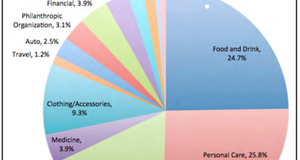From Elon Journal of Undergraduate Research in Communications VOL. 5 NO. 1Brand Identities and Portrayal of Minority Groups in 2013 Super Bowl Automobile AdvertisementsPortrayal of women, gender roles, and sexual orientationFollowing an examination of recurring themes and key differences, the research moved on to analyze how women, gender, and sexual orientation were portrayed in these advertisements. Although every advertisement analyzed featured at least one shot of a woman, the portrayals of women were most often stereotypical or image-based. Traditional gender roles were commonly reinforced by the portrayal of women in some advertisements, and only heterosexual relationships were depicted. For example, the RAV4 advertisement by Toyota is set in a traditional, suburban street and features a typical nuclear family with one daughter, one son, and a mother and father. They are greeted by a very feminine “genie” that will grant them wishes. The wife has few speaking lines, and appears to be simpleminded as her wish is for unlimited chocolate. However, this same advertisement also features the daughter asking to be a princess, but then shows a visual of her on horseback in a battlefield, asking for soldiers to avenge her father. This brief and seemingly of non-stereotypical portrayals was not seen often in the other advertisements analyzed, however. For instance, the VW Beetle advertisement focused the storyline on male workers; while a male is seen driving the car, females only play a minor part. In fact, a male is seen driving the car when a driver is shown in all the advertisements analyzed. On the other hand, when females appeared on screen, they were treated as something to be looked at. For example the Mercedes CLA advertisement portrays a model, Kate Upton, as simply washing the car in slow motion. That’s the whole premise of the commercial. A group of young males also gawk at her in this scene. The female’s portrayal is highly sexualized, and she appears nonthreatened and rather inviting with ample hair tossing and smiling (see Figure 2). This study found the Lincoln advertisement as evidence that females are in these advertisements mostly for visual purposes. Although viewers never see the driver of the Lincoln, they do see a shot of a girl riding in the passenger seat, arms up and smiling invitingly through the sunroof. Once again, the female isn’t driving the car, nor portrayed as someone who would enjoy driving it, but rather as a visual in supporting the narrative being told of how desirable this car is, and how desirable it could make you. The Audi advertisement analyzed shows a similar portrayal of women. A mother is present in the advertisement in a family setting, but she is not included in the storyline of the car and has a minor role. The advertisement tells a story of a high school boy going to his prom after receiving the keys from his father to the Audi and being told to “have fun tonight.” The car is presented as a sort of boy’s toy, as only males are seen getting enjoyment from it or having interest in it. When the boy arrives at prom, he goes straight over to a girl he likes, who is lighted and presented like an object of desire, and kisses her without any warning or consent. He is punched in the face by her boyfriend after that, but the advertisement glorifies the unsolicited kiss by showing him smiling as he drives away, and flashing the tagline “Bravery. It’s what defines us.” Most of the advertisements analyzed, when not appealing to family buyers by showing families, appeared to have masculine undertones. For example, in the RAM advertisement the lighting is dark, the farmers shown on screen are all presented as stoic, male, and hard-working laborers (see Figure 3). Further, the voiceover being read in the background talks about the time in a farmer’s life when his son takes over the farm, and doesn’t mention the possibility that a daughter could do this as well. ConclusionsThis analysis supported the research’s first thesis statement that different brands have unique personalities, which are also reflected in their advertisements. For example, a brand like Volkswagen had a clear brand personality of being fun-loving, easy-going, and targeting a younger audience. All these were evidenced in the advertisements by contextual cues, such as the light-hearted and humorous tone of their advertisements, young main characters, and even the folk-like background music that may appeal to their target demographic. Other brands, such as RAM trucks, also had their brand identities reflected in their advertisements. RAM’s advertisement had highly masculine visuals throughout, and a conservative, hardworking, even religious undertone. All of these characteristics are intentionally in the advertisement because they would appeal to RAM’s target audience and potential buyers. Although most advertisements analyzed had clear brand voices and identity portrayals in their advertisements, some brands’ voices were not clear, especially in Kia’s advertisements. They never seemed to use any distinctive visual or textual cues that would be reflective of a clear, larger brand identity, unlike Volkswagen’s advertisements. The second thesis statement that women, gender-roles and sexual orientation would be different along with the differing brand personalities in advertisements had limited support in the results. This study showed that all of these automobile advertisements even in 2013 still portrayed women in a largely stereotypical, traditional gender-role manner across the board, while they did not mention same-sex relationships at all. No clear differences emerged between brands in how these groups were portrayed, because all of them seemed to include women as more of a visual aid in the advertisement, with few speaking roles, and even obvious objectification of women’s bodies in some advertisements. Perhaps these portrayals can be explained more by the automobile industry’s history of being traditionally a heavily masculine and male-dominated sector, and thus advertisers are pandering to outdated perceptions of men, gender-roles, and the male psyche in these advertisements. Key limitations of this study include only a small number of advertisements from one event, the 2013 Superbowl. Therefore, the conclusions of this study can’t be generalized to a larger sample of advertisements over a different period of time. Future research on the representation of minority groups in the area of automobile advertising could focus on how audiences perceive the portrayals of minority groups. Or further research could examine whether the audience can notice a common theme or brand story portrayed in the advertisements after watching multiple ones from the same manufacturers. AcknowledgementsThis author is thankful to Dr. David Copeland at Elon University for his supervision and advice, without which the article could not be published. The author also appreciates numerous reviewers who have helped revise this article. ReferencesAaker, J., (1997). Dimensions of brand personality. Journal of Marketing Research, 34, 347-356. Retrieved from http://faculty-gsb.stanford.edu/aaker/PDF/Dimensions_of_Brand_Personality.pdf Chatterjee, A., Jauchius, M., Kaas, H., & Satpathy, A. (2002). Revving up auto branding. The McKinsey Quarterly. Portland state school of business administration. Retrieved from Retrieved from EBSCO host Conley, J., & Arlene, M. (2009) Car troubles critical studies of automobility and auto-mobility. Farnham, England: Ashgate Publishing. Ferguson, S., Hardy A., & Williams A., (2003) Content analysis of television advertising for cars and minivans: 1983–1998. Accident Analysis & Prevention, 35(6), 825-831. Hester, J., & Gibson R. (2007). Consumer responses to gay-themed imagery in advertising. Advertising & Society Review, 8(2), 1-14. Advertising Educational Foundation. Retrieved from Project MUSE database at https://muse.jhu.edu/login?auth=0&type=summary&url=/journals/asr/v008/8.2hester_gibson.html Kang, M. (1997). The portrayal of women’s images in magazine advertisements: Goffman’s gender analysis revisited. Sex Roles, 37(11), 979-996. Lindner, K. (2004). Images of women in general interest and fashion magazine advertisements from 1955 to 2002. Sex Roles, 51(7/8), 409-421. Lundstrom, W., & D. Sciglimpaglia. (1977). Sex role portrayals in advertising. Journal of Marketing, 41(3), 72-79. McQuarrie, E., & Phillips B. (2008). Visual analysis of images in brand culture. Go figure! New directions in advertising rhetoric. Armonk, N.Y.: M.E. Sharpe, 277-296. Murphy, L., Moscardo G., & Benckendorff P., (2007). Using brand personality to differentiate regional tourism destinations. Journal of Travel Research, 46(1), 5-14. Schroeder, J., Mörling M., & Askegaard S., (2006). Brand culture. London: Routledge Thornborrow, J. (1998). Playing hard to get: Metaphor and representation in the discourse of car advertisements. Language and Literature, 7(3), 254-272. Tsai, W.S. (2004). Gay advertising as negotiations: Representations of homosexual, bisexual and transgender people in mainstream commercials, GCB - Gender and Consumer Behavior, 7. Retrieved from http:// www.acrwebsite.org/search/view-conference-proceedings.aspx?Id=12086 Suggested Reading from Inquiries Journal
Inquiries Journal provides undergraduate and graduate students around the world a platform for the wide dissemination of academic work over a range of core disciplines. Representing the work of students from hundreds of institutions around the globe, Inquiries Journal's large database of academic articles is completely free. Learn more | Blog | Submit Latest in Business & Communications |





















